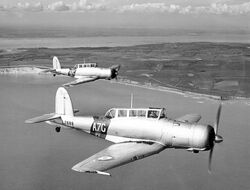The Blackburn B-24 Skua was a carrier based dive bomber/fighter used by Great Britain during the early years of World War II.
Description[]
The Skua was 10.85m long and 3.81m high, with a wingspan of 14.07m. The single 664Kw Perseus XII radial engine gave the Skua a maximum speed of 362 km/h at 1,980m, cruising speed of 266 km/h at 4,570m and an initial climb rate of 482m per minute.
The Skua's service ceiling was 6,160m and its maximum range was 1,223 km. Its empty weight was 2,490 kg, and maximum take off weight was 3,732 kg. Armament consisted of four 7.7mm Browning M1919 machine guns in the wings, a single 7.7mm trainable Lewis Gun in the rear cockpit plus one 227 kg bomb under the fuselage and/or eight 14 kg practice bombs under the wings.[1]
History[]
Development[]
The Skua was designed to O.27/34, a 1934 specification for a Naval dive bomber, which led to the receipt of five design tenders, from Hawker, Boulton Paul, Vickers for their Type 280, Avro for the Type 666 and Blackburn for the D.B.1. The last of these was the only one of the five accepted for prototype purchase, with K5178 and K1579 being ordered in April 1935.[2] These two prototypes, powered by 840 hp Mercury engines, looked sleek against the Navy's fabric covered biplanes.[3]
George Edward Perry's design incorporated flush riveting for it's Alclad construction, a manually folded wing design, and modified Zap flaps which gave a reduced take off run, a stepper landing approach and were designed to act as dive brakes. The first prototype was flown on 9 February 1937 by 'Dasher' Blake, before being passed to the A & AEE for preliminary assessment sometime during the following months.[N 1]
Receiving the name Skua in August 1937, the aircraft was then used for handling, performance and armament trials, which revealed few problems. These were quickly rectified, and the aircraft was described as being easy and pleasant to fly. The second prototype was fitted with upturned wingtips to improve the spinning characteristics, and 190 were eventually built to specification O.25/36 as the Skua Mk II, with the first production aircraft flying on 28 August 1938.[1][N 2]The basic design was later modified as the Blackburn B-25 Roc.[1]

A pair of Skua aircraft in flight
Service[]
Upon entering service with 800 and 803 Squadrons aboard HMS Ark Royal in 1938,[1] the Skua became the Fleet Air Arm's first monoplane, and their first aircraft with variable pitch propeller and retractable undercarriage.[3] By the declaration of war, 801 Squadron aboard HMS Furious, and 806 Squadron, were also equipped with the Skua.[1] During the first year of war, the Skuas worked hard and made many gallant attacks on German capital ships. On 26 September 1939, Skuas of 803 Squadron from HMS Ark Royal shot down a Dornier Do 18, the first Luftwaffe aircraft destroyed by Great Britain.[4]
On 10 April 1940, a force of 16 Skuas from 800 and 803 squadrons took off from Haston in the Orkneys and flew 330 miles across the North Sea to Bergan, in order to carry out a dawn raid against the damaged German light cruiser Konigsberg, sinking her with three SAP bombs. Shortly afterwards, Skuas from 800 Sqn shot down five Heinkel He-111s. However, on 6 June 1940, an attack by 800 and 803 Sqns against the battleship Scharnhorst resulted in eight Skuas being shot down.[5] It was becoming clear that the basic aircraft was underpowered, and by 1941 the Skua was becoming a target tug and trainer.[4]
Notes[]
- ↑ The exact date is unknown, but the transfer took place before the aircraft attended the Hendon Air Display on 26th June.[2]
- ↑ The change in designation was necessitated by the use of a sleeve valve Pegasus XII radial in place of a poppet valve Mercury IX, resulting in the nose being increased in length by 30 in.[2] The change in engine was due to the fact that all Mercury engines were required for the Bristol Blenheim.[1]
References[]
- ↑ 1.0 1.1 1.2 1.3 1.4 1.5 World Aircraft Information Files File 890 Sheet 33 (A-Z of Aircraft:Blackburn B-9 to Blackburn B-25 Roc)
- ↑ 2.0 2.1 2.2 Mason, Francis K. The British Bomber since 1914. Putnam. 1994. ISBN 0 85177 861 5 Page 308
- ↑ 3.0 3.1 Gunston, Bill. The Illustrated Directory of Fighting Aircraft of World War II. Salamander Books Ltd. 1988. ISBN 0 86101 390 5 Page 20
- ↑ 4.0 4.1 Gunston, Bill. Page 21
- ↑ Mason, Francis K. Page 309
| |||||||||||||||||
